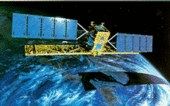Radarsat-1
 Radarsat-1 | |
| Mission type | Earth Observation |
|---|---|
| Operator | CSA |
| COSPAR ID | 1995-059A |
| SATCAT № | 23710 |
| Website | www.asc-csa.gc.ca/eng/satellites/radarsat1/ |
| Mission duration | 5 years |
| Spacecraft properties | |
| Manufacturer |
MDA (formerly Spar) Ball Aerospace |
| Launch mass | 2,713 kilograms (5,981 lb) |
| Power | 2,100 watts |
| Start of mission | |
| Launch date | 4 November 1995, 14:22 UTC |
| Rocket | Delta II 7920-10 |
| Launch site | Vandenberg SLC-2W |
| Contractor | Boeing |
| End of mission | |
| Last contact | 29 March 2013 |
| Orbital parameters | |
| Reference system | Geocentric |
| Perigee | 791 kilometres (492 mi) |
| Apogee | 793 kilometres (493 mi) |
| Inclination | 98.6 degrees |
| Period | 100.70 minutes |
| Main radar | |
| Wavelengths | C band |
Radarsat-1 is Canada's first commercial Earth observation satellite.
Mission
It was launched at 14:22 UTC on November 4, 1995 from Vandenberg AFB in California, into a sun-synchronous orbit (dawn-dusk) above the Earth with an altitude of 798 kilometres (496 mi) and inclination of 98.6 degrees. Developed under the management of the Canadian Space Agency (CSA) in cooperation with Canadian provincial governments and the private sector, it provides images of the Earth for both scientific and commercial applications. Radarsat-1's images are useful in many fields, including agriculture, cartography, hydrology, forestry, oceanography, geology, ice and ocean monitoring, arctic surveillance, and detecting ocean oil slicks.
History
National Aeronautics and Space Administration (NASA) provided the Delta II rocket to launch Radarsat-1 in exchange for access to its data. Estimates are that the project, excluding launch, cost $620 million (Canadian). The Canadian federal government contributed about $500 million, the four participating provinces (Quebec, Ontario, Saskatchewan and British Columbia) about $57 million, and the private sector about $63 million.
Radarsat International, Inc. (RSI), a Canadian private company, was created in 1989 to process, market and distribute Radarsat-1 data. (Radarsat International, Inc. (RSI) was later acquired by MacDonald Dettwiler and Associates.) In 2006, RSI was rebranded MDA Geospatial Services International or MDA GSI.
Payload
Radarsat-1 uses a Synthetic Aperture Radar (SAR) sensor to image the Earth at a single microwave frequency of 5.3 GHz, in the C band (wavelength of 5.6 cm). Unlike optical satellites that sense reflected sunlight, SAR systems transmit microwave energy towards the surface and record the reflections. Thus, Radarsat-1 can image the Earth, day or night, in any atmospheric condition, such as cloud cover, rain, snow, dust or haze.
Each of Radarsat-1's seven beam modes offer a different image resolution. The modes include Fine, which covers an area of 50 km × 50 km (31 mi × 31 mi) 2,500 km2 (970 sq mi)) with a resolution of 10 metres (33 ft); Standard, which covers an area of 100 km × 100 km (62 mi × 62 mi) (10,000 km2 (3,900 sq mi)) and has a resolution of 30 metres (98 ft); and ScanSAR wide, which covers a 500 km × 500 km (310 mi × 310 mi) (250,000 km2 (97,000 sq mi)) area with a resolution of 100 metres (330 ft). Radarsat-1 also has the unique ability to direct its beam at different angles.
Constellation

With an orbital period of 100.7 minutes, Radarsat-1 circles the Earth 14 times a day. The orbit path repeats every 24 days, this means that the satellite is in exactly the same location and can take the same image (same beam mode and beam position) every 24 days. This is useful for interferometry and detecting changes at that location that took place during the 24 days. Using different beam positions, a location can also be scanned every few days.
Radarsat-1 is a right-looking satellite, meaning that microwave beam transmits and receives on the right side of the satellite, relative to its orbital path. As it descends in its orbit from the North Pole, it faces west, and when it ascends from the South Pole, it faces east. Locations can therefore be imaged from opposite sides. Combined with the different beam modes and positions, this provide users with many possible perspectives from which to image a location.
Kongsberg Satellite Services of Norway, among several other external partners, provides ground station services for Radarsat-2 including the provision of data under Canadian Space Agency science programmes.[1] This allows Radarsat-1 to download via both Svalbard Satellite Station in Norway and Troll Satellite Station in Antarctica.[2]
Current status
On November 4, 2010, Radarsat-1 celebrated its 15 year service anniversary.[3] It outlived its planned five-year lifetime by a wide margin. Radarsat-2 was launched on 14 December 2007 from Baikonur, Kazakhstan[4]
Radarsat-1 covered the Arctic daily, and most of Canada every 72 hours depending on instrument orientation and mode. It covered the entire Earth every 24 days.
On March 29, 2013, RADARSAT-1 experienced a technical problem. The Canadian Space Agency (CSA) assembled a team of engineers, who conducted an extensive investigation. Following numerous attempts to resolve the problem, the CSA, in consultation with its commercial data distributor MDA Geospatial Services Inc. concluded that RADARSAT-1 was no longer operational.[5]
See also
References
- ↑ "News - Kongsberg Satellite Services". Ksat.no. Retrieved 2010-12-31.
- ↑ Wormdal, Bård (2011). Satellittkrigen (in Norwegian). Oslo: Pax. p. 13. ISBN 978-82-530-3450-8.
- ↑ "Canadian satellite RADARSAT-1 celebrating 15 years of service to Canada and the world" (Press release). Canadian Space Agency. 4 November 2010. Retrieved 2010-11-15.
- ↑ "Soyuz rocket lifts Canadian radar satellite into space". CBC News. 14 December 2007. Retrieved 2007-12-14.
- ↑ "RADARSAT-1: Seventeen Years of Technological Success" (Press release). Canadian Space Agency. 9 May 2013. Retrieved 2013-05-30.
External links
| ||||||||||||||||||||||
| ||||||||||||||||||||||||||||||
| ||||||||||||||||||||||||||||||||||||||||||||||||||||||||||||||
| ||||||||